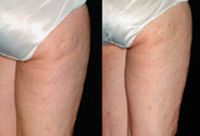- Acne
- Actinic Keratosis
- Aesthetics
- Alopecia
- Atopic Dermatitis
- Buy-and-Bill
- COVID-19
- Case-Based Roundtable
- Chronic Hand Eczema
- Chronic Spontaneous Urticaria
- Drug Watch
- Eczema
- General Dermatology
- Hidradenitis Suppurativa
- Melasma
- NP and PA
- Pediatric Dermatology
- Pigmentary Disorders
- Practice Management
- Precision Medicine and Biologics
- Prurigo Nodularis
- Psoriasis
- Psoriatic Arthritis
- Rare Disease
- Rosacea
- Skin Cancer
- Vitiligo
- Wound Care
Article
Solving the cellulite puzzle
New York - American dermatologists have been ignoring cellulite, but they need to start paying attention, says Mitchel Goldman, M.D., medical director of Dermatology/Cosmetic Laser Associates in La Jolla, Calif.
New York - American dermatologists have been ignoring cellulite, but they need to start paying attention, says Mitchel Goldman, M.D., medical director of Dermatology/Cosmetic Laser Associates in La Jolla, Calif.

Last year, Dr. Goldman gave one of the first American Academy of Dermatology (AAD) lectures on the topic, but getting a slot on the program wasn't easy. The AAD public relations staff was on his side, but the conference committee balked, he says. He prevailed by making the case that:
Defining, treating One of only two dermatologists in the United States researching cellulite, Dr. Goldman describes the condition as a normal physiological condition in post-adolescent women. From an evolutionary perspective, fatter women have a better store of calories for pregnancy and lactation. Adipose tissue also helps with thermal insulation, support and protection of organs.
When adipose deposits increase in the thighs and buttocks, the longitudinal fibers of connective fascia segregate it into channels. But perpendicular tissues remain fixed. This causes the skin to pucker or dimple. In primitive societies, cellulite was a sign of beauty. Today, it's a sign of being overweight and out of shape.
Four modalities Treatment falls into four modalities: lifestyle measures, topical agents,systemic agents and physical therapies. One of the most popular is mesotherapy. Featured often in magazines and television news programs, it involves direct injection of pharmacologic agents into the venous circulation, or local infiltration into the dermal-subcutaneous junction. In theory, the agents reduce cellulite through lipolysis of fat or reduction in the size of adipocytes.
"This has been going on for 10 years in South America," says Dr. Goldman. "There's no scientific evidence it works."
According to Dr. Goldman, cellulite can't be cured. However, the appearance can be improved. Patients want easy, inexpensive treatments that are slow to reverse.
For patients who don't need immediate results, Dr. Goldman recommends using a topical cream, possibly with occlusion, at a cost of approximately $20 for several months of treatment. He has tested several creams, markets one himself, and says some work quite well.
Study results In a recent double-blind, randomized study, Dr. Goldman evaluated the efficacy of a nightly cream on 17 women with moderate to severe cellulite. At the four-week endpoint, 76 percent of subjects reported an overall improvement in their condition. Dermatologist evaluators found improvement in 65 percent of treated legs with occlusion and 59 percent in treated legs without occlusion.
Creams take about a month to work. For patients seeking faster results, Dr. Goldman suggests a three-step program. It begins with ionithermie, which uses lotions to break down fatty deposits and release toxins, followed by galvanic and faradic stimulation. The result is a quick loss in inches around the thighs and hips, improving the appearance of cellulite.
Next comes treatment with a TriActive laser (Cynosure Inc.). The low-energy diode laser was designed to increase lymphatic drainage, tighten the skin, and increase superficial blood flow. (As with ionithermie, there are no published studies validating claims that TriActive improves cellulite.) The regimen is generally one to three treatments a week for a total of 10 to 15 treatments.
Step three is long-term use of a topical cream in combination with diet and exercise.
Newsletter
Like what you’re reading? Subscribe to Dermatology Times for weekly updates on therapies, innovations, and real-world practice tips.














